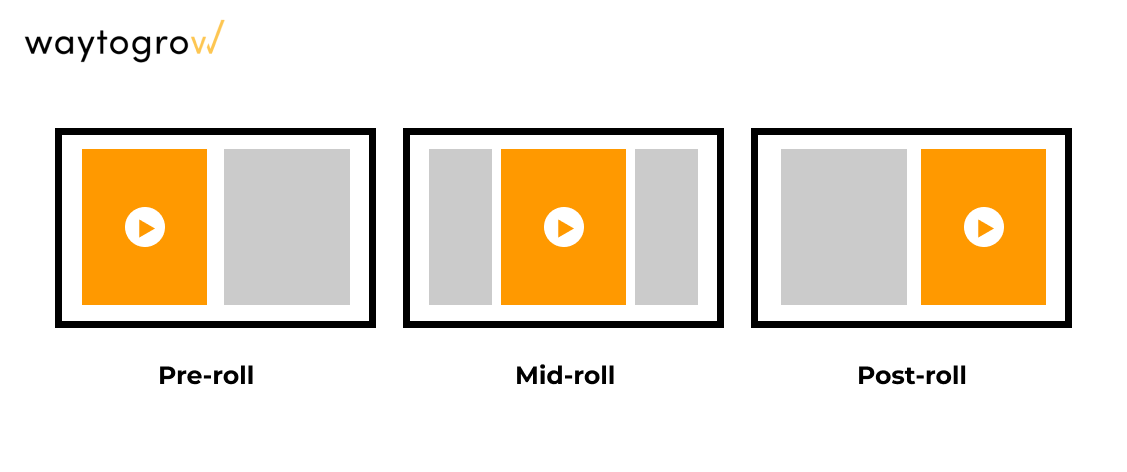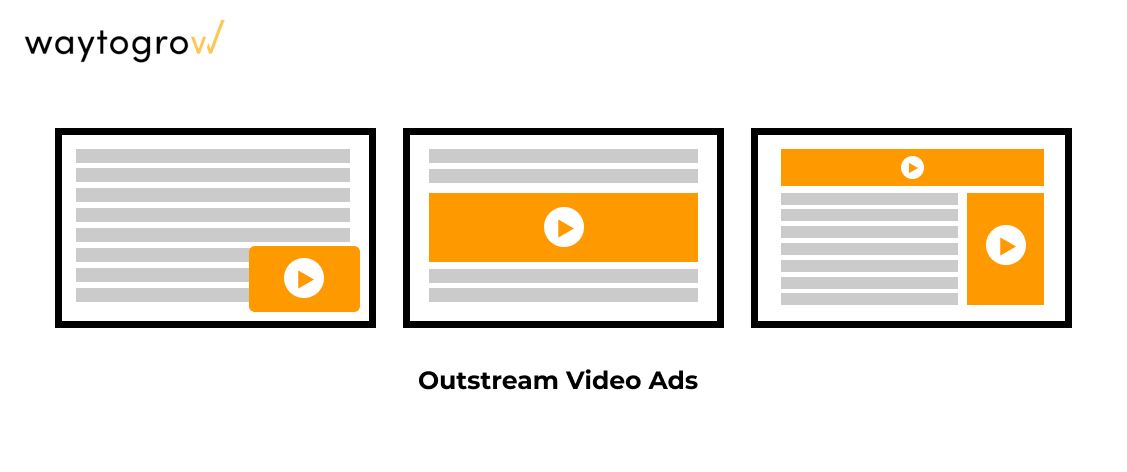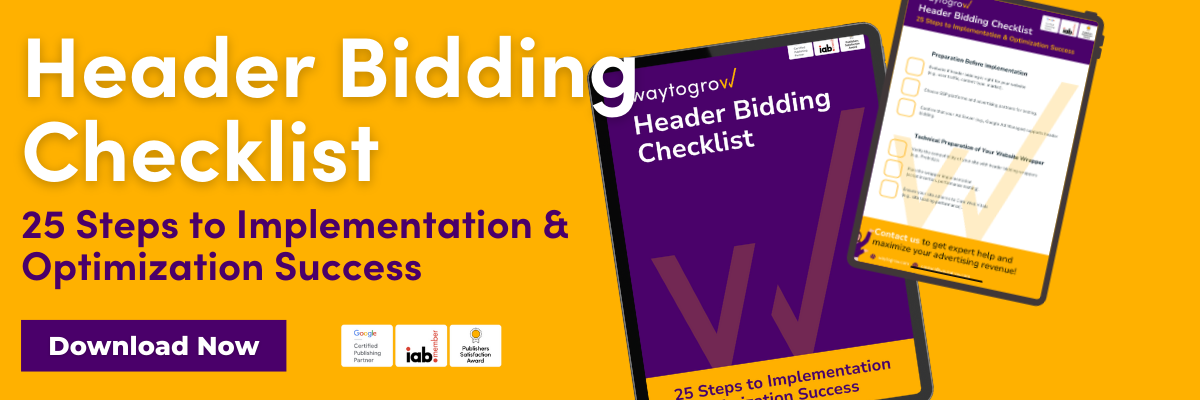In the rapidly evolving digital advertising landscape, video advertising stands out as a compelling medium for publishers and advertisers alike. With video content’s soaring popularity, two ad formats have emerged as front-runners: Instream and Outstream video ads. Each ad format offers unique advantages and challenges, making it crucial for publishers to understand the intricacies of both to leverage them for ad monetization effectively.
What are video ads?
Video advertising is a form of online advertising that uses video to promote products, services, or brands. With the growing popularity of video content, these ads are becoming more and more common among advertisers. They can be displayed on various platforms such as YouTube, streaming services, websites, and mobile applications. Video ads come in various formats, such as pre-roll, mid-roll, post-roll, in-stream, and out-stream, which allows them to be flexibly adapted to different types of content and marketing strategies.
Instream Video Ads
Instream video ads are typically played before (pre-roll), during (mid-roll), or after (post-roll) the main video content, closely mirroring the traditional TV advertising experience. They are most common on platforms where users expect to watch videos, such as YouTube or news websites.

Pros:
- Higher Revenue Potential: Instream video ads are known for their higher CPMs compared to other ad formats. This translates into higher revenue potential for publishers, making them a lucrative option for monetizing video content.
- High-Quality Ads: These ads tend to be of higher quality, both in terms of production and relevance. This not only enhances the user experience on the publisher’s platform but also contributes to maintaining a premium feel to the website or video content.
- Increased Engagement: The pop-out or sticky characteristic of instream video ads ensures that they remain visible to the user even while scrolling, significantly increasing engagement rates. This persistent visibility can lead to better ad performance and, consequently, higher earnings for publishers.
- Integration with Publisher’s Own Video Content: Instream video ads can be seamlessly integrated with a publisher’s video content, ensuring a fluid user experience. This integration allows for a more natural presentation of ads, which can reduce viewer irritation and improve acceptance rates.
- Cross-Platform Linking: For publishers with content across multiple platforms, such as a website and a YouTube channel, instream video ads offer an opportunity for cross-platform linking. This can help drive traffic and viewership across different content repositories, maximizing audience reach and engagement, as well as revenue opportunities.
By leveraging instream video ads, publishers can not only enhance their monetization strategy but also provide their audience with a more engaging and high-quality viewing experience.
Cons:
- Limited to Article-Style Content Pages: Instream video ads are most effective and only applicable within article-style content pages where video content is a natural fit. This limitation can restrict their use across other types of web pages or content formats, potentially reducing their applicability for some publishers. Article-Style Content Pages Potential: Instream video ads can be most effective when they are applicable within article-style pages where video content is a natural fit and extension to written content. This limitation can restrict some publishers which not have such resources and potentially reduce their chances of gaining success for this potential.
- Stricter Policy Guidelines by Google: To ensure a quality advertising space for advertisers, Google enforces much stricter policy guidelines on instream video ads. Publishers need to navigate these guidelines carefully to avoid penalties or the loss of monetization opportunities, requiring constant vigilance and adherence to Google’s standards.
- High Costs Without Own Video Content: For publishers without their own post-ad video content, integrating instream video ads can be costly. The need to create or source video content to precede or follow the ads can introduce significant expenses. However, Waytogrow offers a solution by providing content, mitigating this challenge, and supporting publishers in leveraging Instream video ads effectively.
- Player Server Fees: Implementing instream video ads typically involves player server fees, which can eat into the margins of ad revenue generated through these ads. However, Waytogrow addresses this concern by covering all such fees within our revenue share model, ensuring that publishers can enjoy the benefits of instream video ads without worrying about the additional costs.
Despite these cons, instream video ads remain a powerful tool for publishers looking to monetize their video content effectively. With the right strategies and support from partners like Waytogrow, publishers can navigate these challenges and maximize their revenue potential from video advertising.
Outstream Video Ads
Outstream ads, on the other hand, are designed to play in non-video environments such as text content or news articles. They play automatically when they come into view and should be muted by default, requiring user interaction to enable the sound.

Pros:
- Flexibility in Placement: Outstream ads can be placed in non-video content, such as between article paragraphs or in a sidebar, giving more opportunities for publishers who don’t have video content to monetize their pages.
- Does not require post-roll content: Because out-stream ads do not require the inclusion of video content, they can be widely distributed across various parts of the website, increasing the availability of ad inventory.
- Higher Fill Rates with More Ads Available: Out-stream ads typically offer a larger pool of available ads, which contributes to higher fill rates for publishers. This abundance ensures that ad spaces are monetized more consistently, increasing revenue potential. However, it is worth noting that while fill rates may be higher, the quality of the ads can often be lower compared to the premium nature of instream ads.
- Ease of Application and Fewer Policy Restrictions: Implementing out-stream ads on a website is usually easier and involves fewer restrictions. This makes out-stream advertising an attractive option for publishers looking for a simple way to monetize their content. However, brand safety activities and the exclusion list should be remembered when broadcasting programmatic advertising.
Out-stream advertising provides a flexible and accessible avenue for publishers seeking to enhance their ad monetization strategy. Despite the potential compromise in ad quality, the ease of application and the potential for higher fill rates make out-stream advertising an attractive option for publishers exploring multiple revenue streams.
Cons:
- Lower Revenue Potential: Out-stream ads typically generate lower revenues compared to instream ads due to their lower perceived attractiveness to advertisers. This perceived difference often results in lower bidding rates for out-stream ad spaces, impacting overall monetization efficiency for publishers.
- Lower Quality Ads: Ads displayed in out-stream formats are often of lower quality and often consist of simple animations or text content. This lower quality may degrade the user experience and may not meet the publisher’s content standards or audience expectations.
- Intrusiveness: Out-stream ads are considered more invasive by users, given their tendency to appear unexpectedly in content or take up large areas of the screen. This “in your face” approach can lead to a negative user experience, potentially increasing bounce rates and reducing pageviews over time.
- Lacks Native Feel: Unlike in-stream ads, which can integrate more seamlessly with video content, out-stream ads often lack a native feel. Their placement and format can disrupt the flow of content, making it more noticeable – and not always in a positive way – to users, which can impact engagement and time spent on the site.
Outstream ads represent a trade-off between ease of implementation and potential impact on user experience and revenue. Publishers considering out-stream advertising must carefully consider these factors to decide how best to integrate these ads into their monetization strategy while maintaining a positive user experience.
Advantages and disadvantages of in-stream advertising
In-stream ads are a type of video advertising that appears while video content is playing. They have several key advantages:
- Ability to Reach a Wide Audience: In-stream ads are ideal for reaching large numbers of users, especially on popular video platforms.
- Higher performance compared to other advertising formats: Due to their nature, in-stream ads often achieve higher engagement and conversion rates.
- Ability to display ads in a variety of formats: In-stream ads can be displayed as pre-roll, mid-roll, and post-roll, allowing them to be strategically placed within video content.
However, in-stream advertising also has its disadvantages:
- Potential for audience frustration: Users may feel irritated when forced to watch ads before or during video content.
Need to adjust video player settings: Make sure that all video player settings ensure compliance of this type of advertising with market standards and requirements.
Advertising platforms
There are many advertising platforms that allow you to display video ads. Here are some of the most popular:
- YouTube: This video platform allows you to display video ads in various formats such as pre-roll, mid-roll and post-roll, allowing you to reach a wide audience.
- Google Ads: An advertising platform that allows you to display video ads on various platforms, including YouTube, streaming services and websites. It offers advanced targeting options such as keywords, location and interests.
- Facebook: A social media platform that allows you to display video ads in in-stream and out-stream formats, allowing you to reach users in different contexts.
- Instagram: Like Facebook, Instagram allows you to display video ads in in-stream and out-stream formats, which allows you to integrate ads with your content.
All of these platforms offer various ad targeting options, allowing you to precisely reach the right audience and maximize the effectiveness of your advertising campaigns.
Choosing the Right Format
Deciding between instream and out-stream video ads is pivotal for publishers aiming to craft a monetization strategy that not only boosts revenue but also aligns with user expectations and enriches the overall browsing experience. This choice demands a thorough understanding of your website’s specific needs, audience preferences, and content type, including video material used in various advertising formats.
Instream Video Ads are ideally suited for publishers with a robust base of original video content. These ads can seamlessly complement the viewing experience, keeping audiences engaged and simultaneously generating substantial ad revenue. High engagement rates are a hallmark of instream ads, especially with pre-roll formats, as they capitalize on the viewer’s anticipation for the upcoming video content. However, it’s vital for publishers to find the right balance between ad frequency and content quality to prevent viewer disengagement or irritation. Publisher Pros include:
- Higher Revenue Potential: Instream ads typically command the highest CPMs, translating to significant revenue opportunities.
- High-Quality Ads: These ads are usually of higher quality, enhancing the viewer’s experience.
- Enhanced Engagement: The pop-out/sticky characteristic of Instream ads follows users, maintaining engagement.
- Integration with Publisher Content: They integrate well with publishers’ own video content, offering a cohesive viewing experience.
- Cross-Platform Linking: Provides opportunities for cross-platform promotion, such as linking website content with a YouTube channel.
Publisher Cons to consider are the format’s limitation to article-style content pages, adherence to stringent policy guidelines by Google, potential costs for publishers lacking their own post-ad video content, and player server fees (though mitigated by Waytogrow’s revenue share model covering all fees).
Outstream Ads, on the other hand, offer a viable solution for publishers primarily featuring written content who seek to integrate video advertising without producing their own video content. Outstream ads can be embedded within text articles or displayed in sidebars, unlocking new revenue streams without the overhead of video production. Publisher Pros include:
- Higher Fill Rates: Although the quality might be lower than Instream, outstream ads ensure a steady ad supply.
- Ease of Application: These ads come with fewer restrictions, making them easier to apply to various site types.
However, Publisher Cons highlights lower revenue due to lower ad quality, potential for intrusive user experience, and a lack of native feel compared to instream ads.
Making the Decision for Video Content
The choice between Instream and out-stream ads should reflect a strategic balance aimed at optimizing ad revenue, preserving content integrity, and offering a positive user experience. Publishers should consider their content’s nature, audience engagement strategies, and feedback. Performance metrics, audience insights, and staying abreast of the latest monetization technology trends are essential for making an informed decision that best serves their monetization goals and respects audience preferences.
Ultimately, both Instream and out-stream ads are valuable tools in a publisher’s arsenal for maximizing ad monetization. By carefully weighing their unique advantages and potential challenges, publishers can tailor their video ad strategy to fit their site’s specific needs and audience expectations, ensuring a harmonious balance between revenue generation and user satisfaction.
Share on:










